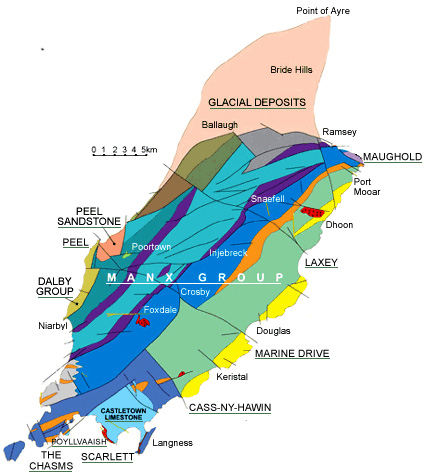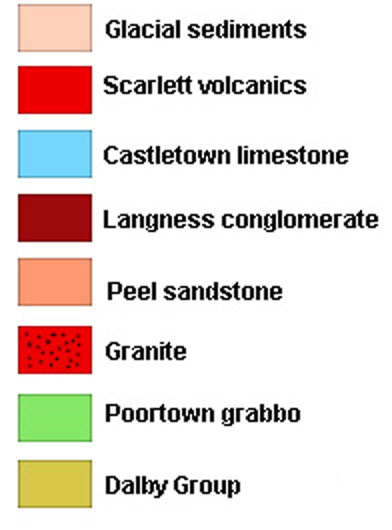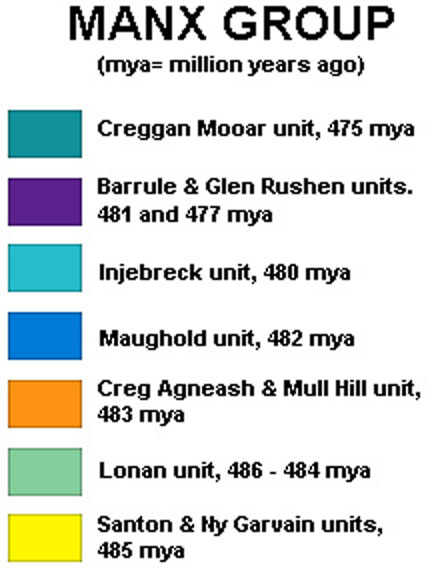Located near Spooyt Vane, one of the highest waterfalls on the Isle of Man is Cabbal Pheric, a 'Keeill', an early Christian chapel that dates back to the 8th-10th centuries. It is dedicated to St. Patrick.
It is thought that keeills were built as oratories or little chapels that would have provided a chance for early Christian missionaries to offer simple services and prayers. They were not designed for congregational worship and services were held outdoors.
There are many keeills on the island and this particular chapel measures around 23 feet by 13 feet with a height of between 28 and 40 inches to the outside. It is though that there was a step down of around 12 inches inside the chapel.
There is a story that the last Priest who officiated in the keeill was guilty of mending his carranes on a Sunday, and in consequence, met with a sudden and dreadful end:
A Mr. Cannell tells the story: The priest of Cabbal Pherick, at the Spooyt Vane, was a cobbler to his trade. One day he was so busy mending a pair of shoes that he did not notice the people passing in the road and looking at him in surprise.
His housekeeper came to him at last and said
'Are you not ashamed to be doing work on the Sabbath and all the people waiting at the Chapel for you?'
'What are thou talking of woman,' he said, 'Go and count the eggs and see how many are in the nest.' For the priest had a hen which laid an egg every day and they were collected only once a week, and that is how he knew what day it would be.
So the woman went, and when she came back she said 'Seven eggs there are.'
Then the priest threw down his tools, and rushed away with such haste that he fell down the Spooyt Vane, and was drowned. And the people never used the Chapel any more.
Another version lays stress on the fact that he waxed his shoe-laces, and when he was crossing the stream he tripped ever them and was carried down the fall!
The stones creating the keeill are boulders of granite, most probably brought up from the shoreline and arranged without mortar into the chapel.



The rocks which form the largest part of the island are known as the Manx Group, many of these were originally formed by sediments deposited on the sea bed and are around 470 to 480 million years old.
Granite containing rock is widely distributed throughout the continental crust. Much of it was intruded during the Precambrian age; it is the most abundant basement rock that underlies the relatively thin sedimentary veneer of the continents. Outcrops of granite tend to form tors and rounded massifs.
The position of the Isle of Man, near the centre of the northern Irish Sea, places it directly in the path of the great ice sheets which have, periodically, over the last 2.4 million years, advanced down that relatively shallow channel. The legacies of these ice sheets, both erosional and depositional, can be seen on the Manx landscape.
Evidence for the ice being glacial rather than local can be seen on an outcrop of quartz rock at Slieau Menagh known as Creg Bedn, where there are striations that can only have been made by ice moving upwards. There are striations made by moving ice visible in many locations island wide, including on surface slate within a few metres of Snaefell summit indicating that during the Ice Age the whole of the island, including the summit of Snaefell, was covered by the ice sheet.
When the glacial period ended in the Irish Sea basin about 12,000 years ago, it left behind boulders and other glacier-borne debris which had been carried within the icecap from lands to the North.
Many of these large boulders can still be seen today and are known as "Erratics". A glacial erratic is a piece of rock that differs from the size and type of rock native to the area in which it rests. Lines of striation and analysis of the rocks show that these mainly came from Scotland. Indeed, evidence of riebeckite microgranite, which is unique to Ailsa Craig off the west coast of Scotland, has been found on many beaches on the island.
The ice also moved local rocks and boulders, including many of Foxdale granite, which crops out at 200 metres on the northern side of South Barrule. A significant number have been found 280 metres above this outcrop and even on the opposite side of South Barrule ridge and it was this phenomenon which convinced Charles Darwin of the glacial theory.
Foxdale Granite is a type of the greater family, pegmatite.
Quartz is the second most abundant mineral in Earth's crust, after feldspar. It has a crystal structure which explains the mineral's appearance.
There are many different varieties of quartz, several of which are semi-precious gemstones. Since antiquity, varieties of quartz have been the most commonly used minerals in the making of jewelry and hardstone carving, especially in Europe and the Middle East.
Quartz is a mineral found in Igneous rock (like currants in a fruit cake). All of the silica and oxygen that make quartz came originally from the insides of stars, and it shot out of the stars when the stars exploded as supernovas. Then the silica formed part of a nebula, a dust cloud floating in space. Nobody knows exactly how the silica got to Earth from the nebula, but once it did, it sank down under the lighter elements of Earth (oxygen and hydrogen, and carbon) but stayed above the heavier elements such as Iron. So silicon got stuck in the middle - not in the core, but not on the surface either. In this middle zone, it was hot enough to melt rock. Most of the silica on Earth is still in this melted state. Only a little of it has reached close enough to the surface to cool down and become solid crystals like quartz in granite.
There are many different kinds of quartz, depending on exactly how it cooled down. Some kinds have large crystals, and some have very small crystals. Small amounts of other materials that get into the stone can give it colors - quartz with a little iron in it is a pink color or a purple color called amethyst. Some kinds of quartz are nearly transparent.
When people want quartz today to make things out of, they often make it themselves in hot furnaces, rather than digging it out of the ground. By controlling the process, people can make perfectly even quartz with no irregularities. People use perfect quartz to make digital watches and computer microprocessors. This is because it vibrates when under electrical current and htis vibration can be measured relatively accurately. Most glass is made by melting sand made of tiny bits of quartz.
Muscovite is a mineral of aluminium and potassium, more commonly known as Mica or Isinglass. It can be incredibly valuable if found in large chunks or quantities as it has excellent fireproofing, insulating and sometimes lubricating qualities.
The mineral is often colourless but can be found with grey, brown, green or yellow tints or sometimes more rarely violet and red.
In order to claim this Earthcache, please answer the following questions:
1. What stone is the predominant building material here? What type of this particular rock do you think it is and what are the key features of it?
2. Look at the exposed stone to the right of the doorway as you enter the ruin. It has a striking feature within it. What does this feature look like - i.e. how big is it, what colour is it? What could this be made of?
3. Where might the material for the chapel be from? How could the rock have got to where it was found?
4. What makes this particular rock a good building material?
5. How big is the chapel?
6. Sit back and enjoy the peace and quiet. If you have a picnic with you, here is a perfect spot for it!